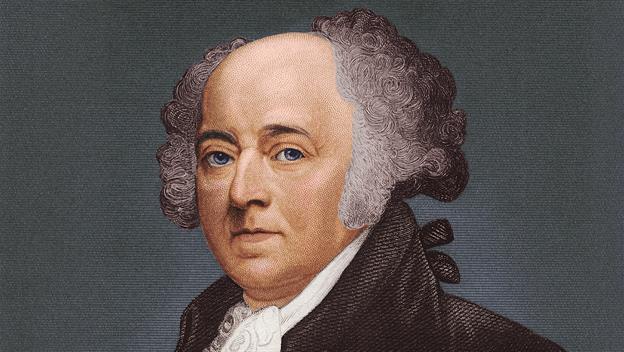1779
On this day in 1779, the Continental Congress appoints John
Adams to travel to France as minister plenipotentiary in charge of
negotiating treaties of peace and commerce with Great Britain during the
Revolutionary War.
Adams had traveled to Paris in 1778 to negotiate an alliance with France, but had been unceremoniously dismissed when Congress chose Benjamin Franklin as sole commissioner. Soon after returning to Massachusetts in mid-1779, Adams was elected as a delegate to the state convention to draw up a new constitution; he was involved in these duties when he learned of his new diplomatic commission. Accompanied by his young sons John Quincy and Charles, Adams sailed for Europe that November aboard the French ship Sensible, which sprang a leak early in the voyage and missed its original destination (Brest), instead landing at El Ferrol, in northwestern Spain. After an arduous journey by mule train across the Pyrenees and into France, Adams and his group reached Paris in early February 1780.
While in Paris, Adams wrote to Congress almost daily (sometimes several letters a day) sharing news about British politics, British and French naval activities and his general perspective on European affairs. Conditions were unfavorable for peace at the time, as the war was going badly for the Continental Army, and the blunt and sometimes confrontational Adams clashed with the French government, especially the powerful Foreign Minister Charles Gravier, Comte de Vergennes. In mid-June, Adams began a correspondence with Vergennes in which he pushed for French naval assistance, antagonizing both Vergennes and Franklin, who brought the matter to the attention of Congress.
By that time, Adams had departed France for Holland, where he was attempting to negotiate a loan from the Dutch. Before the end of the year, he was named American minister to the Netherlands, replacing Henry Laurens, who was captured at sea by the British. In June 1781, capitulating to pressure from Vergennes and other French diplomats, Congress acted to revoke Adams’ sole powers as peacemaker with Britain, appointing Franklin, Thomas Jefferson, John Jay and Laurens to negotiate alongside him.
The tide of the war was turning in America’s favor, and Adams returned to Paris in October 1782 to take up his part in the peace negotiations. As Jefferson didn’t travel to Europe and Laurens was in failing health after his release from the Tower of London, it was left to Adams, Jay and Franklin to represent American interests. Adams and Jay both distrusted the French government (in contrast with Franklin), but their differences of opinion and diplomatic styles allowed the team to negotiate favorable terms in the Peace of Paris (1783). The following year, Jefferson arrived to take Adams’ place as American minister to France, forming a lifelong bond with Adams and his family before the latter left to take up his new post as American ambassador to London and continue his distinguished record of foreign service on behalf of the new nation.

John Adams appointed to negotiate peace terms with British
Adams had traveled to Paris in 1778 to negotiate an alliance with France, but had been unceremoniously dismissed when Congress chose Benjamin Franklin as sole commissioner. Soon after returning to Massachusetts in mid-1779, Adams was elected as a delegate to the state convention to draw up a new constitution; he was involved in these duties when he learned of his new diplomatic commission. Accompanied by his young sons John Quincy and Charles, Adams sailed for Europe that November aboard the French ship Sensible, which sprang a leak early in the voyage and missed its original destination (Brest), instead landing at El Ferrol, in northwestern Spain. After an arduous journey by mule train across the Pyrenees and into France, Adams and his group reached Paris in early February 1780.
While in Paris, Adams wrote to Congress almost daily (sometimes several letters a day) sharing news about British politics, British and French naval activities and his general perspective on European affairs. Conditions were unfavorable for peace at the time, as the war was going badly for the Continental Army, and the blunt and sometimes confrontational Adams clashed with the French government, especially the powerful Foreign Minister Charles Gravier, Comte de Vergennes. In mid-June, Adams began a correspondence with Vergennes in which he pushed for French naval assistance, antagonizing both Vergennes and Franklin, who brought the matter to the attention of Congress.
By that time, Adams had departed France for Holland, where he was attempting to negotiate a loan from the Dutch. Before the end of the year, he was named American minister to the Netherlands, replacing Henry Laurens, who was captured at sea by the British. In June 1781, capitulating to pressure from Vergennes and other French diplomats, Congress acted to revoke Adams’ sole powers as peacemaker with Britain, appointing Franklin, Thomas Jefferson, John Jay and Laurens to negotiate alongside him.
The tide of the war was turning in America’s favor, and Adams returned to Paris in October 1782 to take up his part in the peace negotiations. As Jefferson didn’t travel to Europe and Laurens was in failing health after his release from the Tower of London, it was left to Adams, Jay and Franklin to represent American interests. Adams and Jay both distrusted the French government (in contrast with Franklin), but their differences of opinion and diplomatic styles allowed the team to negotiate favorable terms in the Peace of Paris (1783). The following year, Jefferson arrived to take Adams’ place as American minister to France, forming a lifelong bond with Adams and his family before the latter left to take up his new post as American ambassador to London and continue his distinguished record of foreign service on behalf of the new nation.


No comments:
Post a Comment